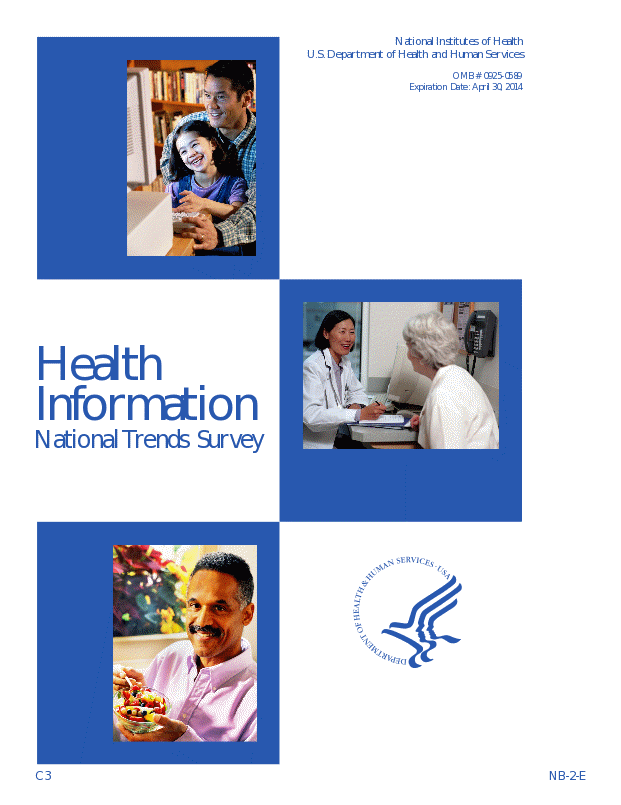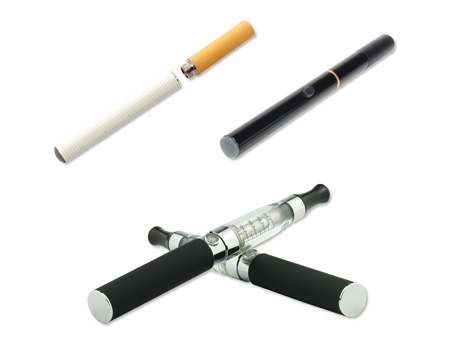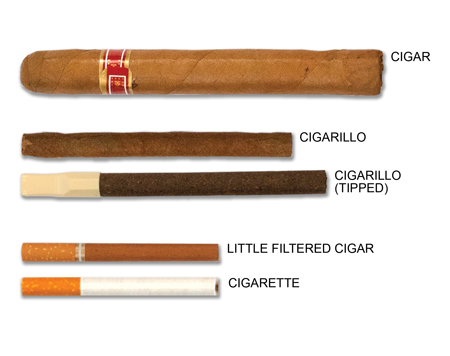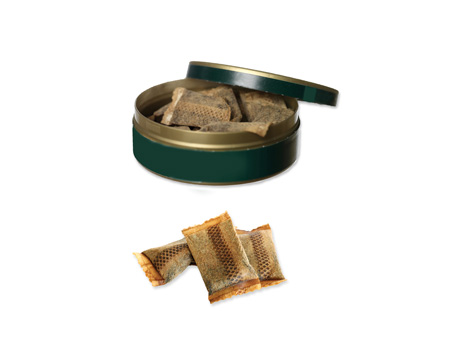Form 1 B1- Instrument in English
Health Information National Trends Survey V (HINTS V) (NCI)
B1 - Instrument in English
Health Information National Trends Survey
OMB: 0925-0538
OMB
# 0925-0538
Expiration
date: XXXXX
FDA



1. Is there more than one person age 18 or older living in this household?


Yes

No GO TO A1 on the next page
2. Including yourself, how many people age 18 or older live in this household?
3. The adult with the next birthday should complete this questionnaire. This way, across all households, HINTS will include responses from adults of all ages.
4. Please write the first name, nickname or initials of the adult with the next birthday. This is the person who should complete the questionnaire.
Si prefiere recibir la encuesta en español, por favor llame 1-888-738-6812

STATEMENT OF PRIVACY: Collection of this information is authorized by The Public Health Service Act, Sections 411 (42 USC 285 a) and 412 (42 USC 285a-1.a and 285a1.3). The purpose of this data collection is to evaluate whether the survey questions are easy to understand. The results of the data collection will be used to improve the survey instrument. Rights of study participants are protected by The Privacy Act of 1974. Participation is voluntary, and there are no penalties for not participating or withdrawing from the study at any time. Refusal to participate will not affect your benefits in any way. The information collected in this study will be kept private under the Privacy Act and will only be seen by people authorized to work on this project. The report summarizing the findings will not contain any names or identifying information. Identifying information will be destroyed when the project ends.
NOTIFICATION TO RESPONDENT OF ESTIMATED BURDEN: Public reporting burden for this collection of information is estimated to average 30 minutes per response, including the time for reviewing instructions, searching existing data sources, gathering and maintaining the data needed, and completing and reviewing the collection of information. An agency may not conduct or sponsor, and a person is not required to respond to, a collection of information unless it displays a currently valid OMB control number. Send comments regarding this burden estimate or any other aspect of this collection of information, including suggestions for reducing this burden to: NIH, Project Clearance Branch, 6705 Rockledge Drive, MSC 7974, Bethesda, MD 20892-7974, ATTN: PRA (0925-0538). Do not return the completed form to this address
A: Looking For Health Information |
A1. Have you ever looked for information about health or medical topics from any source?


Yes

No GO TO A4 in the next column

X
A2. The most recent time you looked for information about health or medical topics, where did you go first?
Mark only one.
Books
Brochures, pamphlets, etc.
Public Health organization
Family
Friend/Co-worker
Doctor or health care provider
Internet
Library
Magazines
Newspapers
Telephone information number
Complementary, alternative, or unconventional practitioner
A3. Based on the results of your most recent search for information about health or medical topics, how much do you agree or disagree with each of the following statements?

|

|
|
|
|
a. It took a lot of effort to get the information you needed |
|
|
|
|
b. You felt frustrated during your search for the information |
|
|
|
|
c. You were concerned about the quality of the information |
|
|
|
|
d. The information you found was hard to understand |
|
|
|
|
A4. In general, how much would you trust information about health or medical topics from each of the following?


|
|
|
|
|
a. A doctor |
|
|
|
|
b. Family or friends |
|
|
|
|
c. Government health agencies (e.g., the Food and Drug Administration (FDA), National Institutes of Health (NIH) or Centers for Disease Control and Prevention (CDC)) |
|
|
|
|
d. Health organizations or groups (e.g., the American Cancer Society, American Lung Association or others) |
|
|
|
|
e. Charitable organizations |
|
|
|
|
f. Religious organizations and leaders |
|
|
|
|
A5. On a typical weekday, about how many hours do you…
|
Hours |
|||
|
|
|||
a. watch television |
|
|
||
b. listen to the radio |
|
|
||
c. use the internet for personal reasons |
|
|
||
A6. During a typical weekend, about how many hours do you…
|
Hours |
|||
|
|
|||
a. watch television |
|
|
||
b. listen to the radio |
|
|
||
c. use the internet for personal reasons |
|
|
||
A7. In the past seven days, how many days did you read a newspaper?
-
days

Electronic cigarettes
Questions A8-A11 are about electronic cigarettes or e-cigarettes such as those shown in the image above. You may also know them as vape-pens, hookah-pens, e-hookahs, or e-vaporizers. Some look like cigarettes and others look like pens or small pipes. These are battery-powered, usually contain liquid nicotine, and produce vapor instead of smoke.
A8. Have you ever looked for information on electronic cigarettes from any source?


Yes

No GO TO A11 in the next column


X
X
A9. What kinds of information on electronic cigarettes have you ever looked for from any source?
Mark all that apply.
Health effects
Using electronic cigarettes to quit or reduce smoking
List of chemicals in electronic cigarettes
Cost/Coupons
Instructions/Tutorials
Where to buy
Reviews/Ratings of brands


Something else – Specify

A10. What information did you look for the most recent time you looked for information about electronic cigarettes?

X
Mark only one.
Health effects
Using electronic cigarettes to quit or reduce smoking
List of chemicals in electronic cigarettes
Cost/Coupons
Instructions/Tutorials
Where to buy
Reviews/Ratings of brands


Something else – Specify

A11. In general, how much would you trust information about the health effects of electronic cigarettes from each of the following?


|
|
|
|
|
a. A doctor/pharmacist/health care provider |
|
|
|
|
b. Family or friends |
|
|
|
|
c. Government health agencies (e.g., the Food and Drug Administration (FDA), National Institutes of Health (NIH), or Centers for Disease Control and Prevention (CDC)) |
|
|
|
|
d. Health organizations or groups (such as the American Cancer Society, American Lung Association or others) |
|
|
|
|
e. Religious organizations and leaders |
|
|
|
|
f. Tobacco companies |
|
|
|
|
g. Electronic cigarette companies |
|
|
|
|

X
A12. Have you ever looked for any of the following information about tobacco products (e.g. cigarettes, cigars, or chewing tobacco) from any source?
Mark all that apply.
Health effects
Products that claim to reduce exposure to certain chemicals or present less risk of disease
Quitting help/information
List of chemicals in tobacco products
Cost/Coupons
Instructions/Tutorials
Where to buy
Information about new kinds of

GO TO A14
in the next column
tobacco products

Never looked for any
of this information


Something else – Specify


X
A13. If you have looked for information about tobacco products, what information did you look for the most recent time you looked?
Mark all that apply.
Health effects
Products that claim to reduce exposure to certain chemicals or present less risk of disease
Quitting help/information
List of chemicals in tobacco products
Cost/Coupons
Instructions/Tutorials
Where to buy
Information about new kinds of tobacco products


Something else – Specify

A14. Overall, how confident are you that you could get health information about tobacco products if you needed it?
Completely confident
Very confident
Somewhat confident
A little confident
Not confident at all
A15. In general, how much would you trust information about the health effects of using tobacco from each of the following?


|
|
|
|
|
a. A doctor/pharmacist/health care provider |
|
|
|
|
b. Family or friends |
|
|
|
|
c. Government health agencies (e.g., the Food and Drug Administration (FDA), National Institutes of Health (NIH), or Centers for Disease Control and Prevention (CDC)) |
|
|
|
|
d. Health organizations or groups (such as the American Cancer Society, American Lung Association or others) |
|
|
|
|
e. Religious organizations and leaders |
|
|
|
|
f. Tobacco companies |
|
|
|
|
A16. In the past 30 days, how often have you seen, heard, or read a message about the health effects of tobacco use from each of the following sources?

|

|
|
|
a. Television |
|
|
|
b. News websites (e.g. CNN.com) |
|
|
|
c. Health websites (e.g. WebMD.com) |
|
|
|
d. Government websites (e.g. FDA.gov) |
|
|
|
e. Social Media (such as Facebook or Twitter) |
|
|
|
f. Magazine |
|
|
|
g. Newspaper |
|
|
|
h. Radio |
|
|
|
i. Billboard |
|
|
|
j. Public transportation |
|
|
|
k. Mailings |
|
|
|
l. Community event |
|
|
|
m. Point of sale (such as at or inside convenience stores, drug stores or supermarkets) |
|
|
|
B: Using the Internet to Find Information |
B1. Do you ever go on-line to access the Internet or World Wide Web, or to send and receive e-mail?


Yes

No GO TO C1 on the next page
B2. How often do you access the Internet through each of the following?

|
|
|
|
|
|
|
a. Computer at home |
|
|
|
|
|
|
b. Computer at work |
|
|
|
|
|
|
c. Computer at school |
|
|
|
|
|
|
d. Computer in a public place (library, community center, other) |
|
|
|
|
|
|
e. On a mobile device (cell phone/smart phone/tablet) |
|
|
|
|
|
|
f. On a gaming device/ “Smart TV” |
|
|
|
|
|
|
g. Other |
|
|
|
|
|
|
B3. Some people notice information about health on the Internet, even when they are not trying to find out about a health concern they have or someone in their family has. Have you read such health information on the Internet in the past 12 months?


Yes

No GO TO B5 on the next page
B4. About how often have you read this sort of information in the past 12 months?
Once a month or more
Less than once a month
B5. Sometimes people use the Internet specifically for health-related reasons.
In the past 12 months, have you used the Internet for any of the following reasons?
|
|
Yes |
No |
|
|
|
|
|
|
a. Looked for health or medical information for yourself |
|
|
|
|
b. Looked for health or medical information for someone else |
|
|
|
|
c. Looked for information about quitting smoking |
|
|
|
|
d. Participated in an online forum or support group for people with a similar health or medical issue |
|
|
|
|
e. Used a website to help you with your diet, weight, or physical activity |
|
|
|
|
f. Looked for a health care provider |
|
|
|
|
g. Downloaded health information to a mobile device, such as an MP3 player, cell phone, tablet computer, or electronic book device |
|
|
|
|
h. Shared health information on social media sites, such as Facebook or Twitter |
|
|
|
|
i. Exchanged support about health concerns with family or friends |
|
|
|
|
j. Kept track of personal health information such as care received, test results, or upcoming medical appointments |
|
|
|
|
k. Watched a health-related video on YouTube |
|
|
|
|
C: Tobacco Product Use |
C1. Have you smoked at least 100 cigarettes in your entire life?
Yes
No

C2. Do you now smoke cigarettes every day, some days or not at all?


Everyday
Some days

Not at all GO TO C4 below

C3. Are you seriously considering quitting smoking cigarettes in the next six months?
Yes GO TO C5 on the next page
No
C4. About how long has it been since you completely quit smoking cigarettes?
Less than 2 weeks
2 weeks to less than 1 month ago
1 month to less than 3 months ago
3 months to less than 6 months ago
6 months to less than 1 year ago
1 year to less than 5 years ago
5 years to less than 15 years ago
15 years ago or more
C5. How much do you agree or disagree with this statement:
“Smoking behavior is something basic about a person that they can’t change very much.”
Strongly agree
Somewhat agree
Somewhat disagree
Strongly disagree
C6. There are a number of resources that people use to help them stop smoking such as telephone quitlines (e.g., 1-800-QUIT-NOW) or websites (e.g., www.smokefree.gov)
Before being contacted for this survey (and regardless of whether or not you smoke), had you ever heard of telephone quitlines or websites for help with quitting smoking?


Yes

No GO TO C9 below
C7. Have you ever called a telephone quitline or visited a website for help with quitting smoking?
Yes
No
C8. How likely would you be to call a quitline or visit a website for help with quitting smoking in the future?
Very likely
Somewhat likely
Somewhat unlikely
Very unlikely

Size of cigars, cigarillos, litte filtered cigars and cigarettes.
C9. How many cigars, cigarillos, or little filtered cigars have you smoked in your entire life? Some popular brands include Macanudo, Romeo y Julieta, Black and Mild, Swisher Sweets, Prime Time, and Cheyenne.
None
1-10
11-20
21-50
51-99
100 or more

C10. Do you now smoke cigars, cigarillos, or little cigars every day, some days or not at all?


Everyday
Some days

Not at all GO TO C12 on the next page

X
C11. Is the size of the cigars, cigarillos, or little filtered cigars that you usually smoke…
Mark only one.
Regular or large cigars like Macanudo, Romeo y Julieta, Arturo Fuente, or others
Medium cigars or cigarillos like Black and Mild, Swisher Sweets, Dutch Masters, Phillies Blunts, or others
Little filtered cigars like Prime Time little filtered cigars, Winchester little filtered cigars, or others
Please refer to the images on the right side of this page to answer questions C12 - C15.

X
C12. Before this survey, which of the following tobacco products have you ever heard of?
Mark all that apply.
Hookah or water pipe filled with tobacco
Electronic Cigarettes or e-cigarettes (such as blu, NJOY or Logic), also known as vape-pens, hookah pens, ehookahs, or e-vaporizers
Pipe filled with tobacco
“Roll your own” cigarettes
Snus (such as Camel snus, General snus, Marlboro snus, and Nordic Ice)

I have not heard of any of these tobacco products GO TO C14 below

X
C13. Which of the following tobacco products have you ever tried even once?
Mark all that apply.
Hookah or water pipe filled with tobacco
Electronic Cigarettes (such as blu, NJOY or Logic), also known as vape-pens, hookah pens, ehookahs, or e-vaporizers
Pipe filled with tobacco
“Roll your own” cigarettes
Snus (such as Camel, Marlboro, Skoal or Swedish Match snus)
I have never tried any of these tobacco
products
C14. Have you used chewing tobacco, snus, snuff, or dip, at least 20 times in your entire life? Some popular brands include Redman, Levi Garrett, Beechnut, Skoal or Copenhagen.
Yes
No
C15. Do you now use chewing tobacco, snus, snuff, or dip every day, some days or not at all?
Everyday
Some days
Not at all

Image 1. Hookah/water pipe

Image 2. Electronic cigarettes

Image 3. Snus
C16. Were any of the tobacco products you used in the past 30 days flavored to taste like menthol (mint), clove, spice, alcohol (wine, cognac), candy, fruit, chocolate, or other sweets?
Yes
No
Don’t know
I have not used any tobacco products in the past 30 days.
C17. Of the five closest friends or acquaintances that you spend time with on a regular basis, how many of them use any kind of tobacco?
0
1
2
3
4
5
C18. How soon after you wake up do you usually use any tobacco product?
I do not use tobacco products
Within 5 minutes
From 6 to 30 minutes
From 31 to 60 minutes
After 60 minutes
I rarely want to use a tobacco product
C19. How much do you agree or disagree with the following statements?

|

|
|
|
|
|
|
a. Nicotine is the main substance in tobacco that makes people want to smoke |
|
|
|
|
|
|
b. The nicotine in cigarettes is the substance that causes most of the cancer caused by smoking |
|
|
|
|
|
|
c. Addiction to nicotine is something that I am concerned about |
|
|
|
|
|
|
C20. Overall, how addictive do you believe each of the following is?


|
|
|
|
|
a. Cigarette smoking |
|
|
|
|
b. Cigar smoking |
|
|
|
|
c. Smokeless tobacco use |
|
|
|
|
d. Using electronic cigarettes or e-cigarettes (also known as vape-pens, e-hookahs, or e-vaporizers) |
|
|
|
|
e. Smoking tobacco in a hookah |
|
|
|
|
f. Smoking “roll your own” cigarettes |
|
|
|
|
g. Smoking a pipe filled with tobacco |
|
|
|
|
D: Beliefs about Tobacco Products |
D1. In the past year, how often have you thought about the chemicals contained in tobacco products?
Never
Rarely
Sometimes
Often

X
D2. Where do you think the chemicals in cigarettes and cigarette smoke come from?
Mark only one.
All the chemicals come from the tobacco leaf
Most of the chemicals come from the tobacco leaf
The chemicals come equally from the tobacco leaf and things added to the tobacco
Most of the chemicals come from things added to the tobacco
All the chemicals come from things added to the tobacco
I do not believe there are any chemicals in cigarettes and cigarette smoke
D3. How long do you think someone has to smoke cigarettes before it harms their health?
Less than 1 year
1 year
5 years
10 years
20 years or more
D4. How much do you think people harm themselves when they smoke a few cigarettes every day?
No harm
Little harm
Some harm
A lot of harm
D5. How much do you think people harm themselves when they smoke 10 or more cigarettes every day?
No harm
Little harm
Some harm
A lot of harm
D6. How harmful do you think each of the following is to a person’s health?

|

|
|
|
a. Cigarette smoking |
|
|
|
b. Cigar smoking |
|
|
|
c. Smokeless tobacco use |
|
|
|
d. Electronic cigarette use |
|
|
|
e. Smoking tobacco in a hookah |
|
|
|
f. Smoking “roll your own” cigarettes |
|
|
|
g. Smoking a pipe filled with tobacco |
|
|
|
D7. New types of cigarettes are now available called electronic cigarettes or e-cigarettes (also known as vape-pens, hookah pens, e-hookahs, or e-vaporizers). These products deliver nicotine through a vapor. Compared to smoking cigarettes, would you say that electronic cigarettes are …
Much less harmful
Less harmful
Just as harmful
More harmful
Much more harmful
I’ve never heard of electronic cigarettes
I don’t know enough about these products
D8. In your opinion, do you think that some smokeless tobacco products, such as chewing tobacco, snus and snuff, are less harmful to a person's health than cigarettes?
Yes
No
Don’t know
D9. How much do you think people harm themselves when they use smokeless tobacco, such as chewing tobacco, snuff, dip, or snus, every day?
No harm
Little harm
Some harm
A lot of harm
D10. How much do you think people harm themselves when they use smokeless tobacco, such as chewing tobacco, snuff, dip, or snus, some days but not every day?
No harm
Little harm
Some harm
A lot of harm
D11. Please indicate how much you agree or disagree with the following statement:
“Tobacco is safer to use now than it was 5 years ago.”
Strongly agree
Somewhat agree
Somewhat disagree
Strongly disagree
D12. In your opinion, do you think that some types of cigarettes are less harmful to a person's health than other types?
Yes
No
Don’t know
D13. Do you believe that anyone regulates statements from tobacco companies about the contents or health effects of their tobacco products?



GO TO D15 below
Yes
No
Don’t know

X
D14. Who do you believe regulates statements that tobacco companies make about the contents or health effects of their tobacco products?
Mark all that apply.
Centers for Disease Control and Prevention (CDC)
Federal Trade Commission (FTC)
Food and Drug Administration (FDA)
National Institutes of Health (NIH)
Surgeon General
Tobacco industry/tobacco companies
None of the above
D15. Do you believe that the United States Food and Drug Administration (FDA) regulates tobacco products in the U.S.?
Yes
No
Don’t know
D16. In your opinion, how qualified is the United States Food and Drug Administration (FDA) to regulate tobacco products?
Not at all
A little
Somewhat
Very
E: Beliefs About Cigarette Claims |
E1. Compared to a typical cigarette, would you think that a cigarette advertised as “low nicotine” would be…
Much more harmful to your health than a typical cigarette?
Slightly more harmful to your health than a typical cigarette?
Equally harmful to your health as a typical cigarette?
Slightly less harmful to your health than a typical cigarette?
Much less harmful to your health than a typical cigarette?
E2. Compared to a typical cigarette, would you think that a cigarette advertised as “low nicotine” would be…
Much more addictive than a typical cigarette?
Slightly more addictive than a typical cigarette?
Equally addictive as a typical cigarette?
Slightly less addictive than a typical cigarette?
Much less addictive than a typical cigarette?
E3. How believable is it that a cigarette could be “low nicotine”?
Not at all believable
A little believable
Somewhat believable
Very believable
E4. How likely do you think it is that tobacco products could be made without some of the chemicals that are harmful to health?
Very likely
Somewhat likely
Somewhat unlikely
Very unlikely
E5. If a tobacco product made a claim that it was less addictive than other tobacco products, how likely would you be to use that product?
Very likely
Somewhat likely
Somewhat unlikely
Very unlikely
E6. If a tobacco product made a claim that it was less harmful to health than other tobacco products, how likely would you be to use that product?
Very likely
Somewhat likely
Somewhat unlikely
Very unlikely
F: Dietary Supplements |
These next questions ask about dietary supplements such as vitamins, minerals, herbs, and other supplements that you may take in addition to your regular diet.
F1. Please indicate whether or not you have taken one or more of the following types of dietary supplement(s) in the past 12 months:
|
|
Yes |
No |
|
|
|
|
|
|
a. Multi-vitamins or multi-mineral supplements, such as One-A-Day, Mega-Vitamin, or Centrum Silver |
|
|
|
|
b. Specialized or single-ingredient vitamins or minerals, such as calcium, Vitamin B, or magnesium |
|
|
|
|
c. Herbs, botanicals, or other supplements (not including vitamins or minerals), such as Echinacea, ginkgo, fish oil, garlic pills, or glucosamine |
|
|
|
|
F2. In the past 12 months, have you experienced any health problem that you thought might be related to any dietary supplements you took?
Yes

No GO TO G6 on the next page

X
F3. The last time you had such a problem, what were the major symptoms of the problem?
Mark all that apply.
Heart problems/chest pain
Abdominal pain
Headache
Rashes
Allergy/reaction
Nausea
Blood pressure problems
Diarrhea
Cramping/muscle aches
Sleep problems
Dizziness/fainting
Itching
Anxiety/nervousness
Drowsiness

Vomiting

Other symptom -Specify

X
F4. What supplement(s) did you think was(were) related to your problem?
Mark all that apply.
Multi-vitamins
“Xenadrine”
Unspecified vitamins/minerals
Iron
Ginko Biloba
Vitamin C
Calcium
“Metabolife”
Vitamin E
Ginseng
“Phen Phen”
St. John’s wort
Vitamin B
Other supplement(s) -Specify

F5. Did you report your problem to any of the following institutions or professionals?
|
Yes |
No |
|
|
|
|
|
a. The Food and Drug Administration |
|
|
|
b. The CDC, Centers for Disease Control and Prevention |
|
|
|
c. A health department or poison control center |
|
|
|
d. The manufacturer of the dietary supplement |
|
|
|
e. Your doctor |
|
|
|
F6. Have you given any dietary supplements to any infant(s), child(ren), or adolescent(s) in your family in the past 12 months?

Yes

No GO TO F9

F7. If yes, what was the reason for using the supplement?

F8. If yes, please provide the name(s) of the supplement(s):
F9. If a dietary supplement product says on its package that it "may produce anticarcinogenic effects in the body," does this mean that the product may do any of the following things?
|
Yes |
No |
Not Sure |
|

|
|
|
a. Reduce the risk of cancer |
|
|
|
b. Treat cancer |
|
|
|
c. Completely prevent cancer |
|
|
|
d. Cure cancer |
|
|
|
F10. In your opinion, if a dietary supplement product says on its package that it "may produce anticarcinogenic effects in the body," does this mean the product may reduce the risk of…
A single type of cancer?
A few or some types of cancer?
All cancers?
Not sure
F11. In your opinion, if a dietary supplement product says on its package that it "may reduce the risk of certain cancers," does this mean the product may reduce the risk of:
A single type of cancer?
A few or some types of cancer?
All cancers?
Not sure
G: Beliefs About Cancer |
G1. How much do you agree or disagree with each of the following statements?

|

|
|
|
|
a. Cancer is most often caused by a person's behavior or lifestyle |
|
|
|
|
b. It seems like everything causes cancer |
|
|
|
|
c. There's not much you can do to lower your chances of getting cancer |
|
|
|
|
d. There are so many different recommendations about preventing cancer, it's hard to know which ones to follow |
|
|
|
|
G2. Which of the following is closest to your opinion about how cancers can be cured?
All types of cancers can be cured in the same way.
Some types of cancers, but not all can be cured in the same way.
Each type of cancer is cured in a different way.
There is no cure for cancer.
G3. Which of the following is closest to your opinion about people’s ability to avoid cancers through what they eat or drink?
All cancers can be avoided through what people eat or drink.
Some cancers, but not all can be avoided through what people eat or drink.
What people eat or drink does not affect their ability to avoid cancers.
G4. Which of the following is closest to your opinion about how dietary supplements affect people’s ability to avoid cancer?
All cancers can be avoided through dietary supplements.
Some types of cancers, but not all can be avoided through dietary supplements.
Dietary supplements do not affect people’s ability to avoid cancer.
G5. Which of the following is closest to your opinion about treating cancer with dietary supplements instead of drugs or surgery?
All cancers can be treated with dietary supplements instead of drugs or surgery.
Some types of cancers, but not all can be treated with dietary supplements instead of drugs or surgery.
Cancers cannot be treated with dietary supplements.
H: Medical Products and Food Safety |
In this section, please think about news reports you hear about medical products and foods, the Food and Drug Administration’s (FDA) activities, and how these affect your choices.
H1. How much attention do you pay to reports of FDA investigations?
None
A little
A lot
H2. If the FDA reports that it is investigating an approved drug, what does it mean to you?
The drug is safe to use
I am unsure whether the drug is safe to use
The drug is not safe to use
H3. Many people take medicine for pain.
How often do you use medicine for pain by prescription only?
More than four times daily
One to four times daily
Less than one time daily
Not applicable
H4. How often do you use non-prescription medicine for pain such as aspirin, acetaminophen, ibuprofen, or naproxen?
More than four times daily
One to four times daily
Less than one time daily
Not applicable
H5. If a prescription drug you take is recalled and you hear that some people who use the drug have been hospitalized, would you...
|
|
Yes |
No |
Not Sure |
|||||
|
|

|
|
|
|||||
|
a. Check the number on your pill bottle to see if it matches the numbers in the recall notice? |
|
|
|
|
||||
|
b. Stop taking the drug immediately?. |
|
|
|
|
||||
|
c. Continue taking the drug but watch for symptoms reported in the recall notice? |
|
|
|
|
||||
d. Ask your doctor what to do? |
|
|
|
|
|
||||
H6. If a brand of canned food that you have in your home was recalled because some people became seriously ill after eating it, how likely would you be to…

|
|

|
|
|
|
|||||
a. Switch brands |
|
|
|
|
|
|||||
b. Ask your doctor what to do. |
|
|
|
|
|
|||||
c. Check the number of the can to see if it matches any of the numbers in the recall notice |
|
|
|
|
|
|||||
d. No longer buy any brand of that food |
|
|
|
|
|
|||||
e. Pay no attention to the recall/keep buying and eating that brand |
|
|
|
|
|
|||||


f. Other -specify |
|
|
|
|
|
|||||

H7. Lasers are in common use in products such as CDs, DVDs and laser printers. Doctors use lasers to treat skin conditions. Lasers are also used in light shows at concerts.
How much do you agree that direct exposure to lasers may damage your skin and eyes?
Strongly agree
Agree
Disagree
Strongly disagree
No opinion
H8. Would you agree or disagree with the following statements?


|
|
|
|
|
|
a. The food I buy is safe to eat |
|
|
|
|
|
b. Cosmetics are tested for safety before they go on the market |
|
|
|
|
|
c. Pet foods are tested for safety before they go on the market |
|
|
|
|
|
d. The drugs I buy without a prescription are tested to see if they are safe before they go on the market |
|
|
|
|
|
e. Vaccines that I get are tested to see if they are safe before they go on the market |
|
|
|
|
|
f. Prescription drugs that I buy are tested to see if they are safe before they go on the market |
|
|
|
|
|
H9. Would you agree or disagree with the following statement?
Medical equipment (including prescription eyeglasses, hearing aids, blood glucose kits, thermometers, pregnancy test kits, and contact lenses) is tested to see if it is effective before it goes on the market.
Strongly agree
Agree
Disagree
Strongly disagree
No opinion
I: You and Your Household |
I1. What is your age?
-
Years old

X
I2. What is your current occupational status?
Mark only one.
Employed
Unemployed
Homemaker
Student
Retired

Disabled

Other-Specify
I3. Have you ever served on active duty in the U.S. Armed Forces, military Reserves or National Guard? Active duty does not include training in the Reserves or National Guard, but DOES include activation, for example, for the Persian Gulf War.
Yes, now on active duty
Yes,
on active duty in the last 12 months but
not now
Yes,
on active duty in the past, but not in the
last 12 months
No, training for Reserves or National Guard only
No, never served in the military
I4. What is your marital status?
Married
Living as married
Divorced
Widowed
Separated
Single, never been married
I5. What is the highest grade or level of schooling you completed?
Less than 8 years
8 through 11 years
12 years or completed high school
Post
high school training other than college
(vocational or
technical)
Some college
College graduate
Postgraduate
I6. Were you born in the United States?

Yes GO TO I8 below


No
I7. In what year did you come to live in the United States?
-
Year
I8. How well do you speak English?
Very well
Well
Not well
Not at all

X
I9. Are you of Hispanic, Latino/a, or Spanish origin? One or more categories may be selected.
Mark all that apply.
No, not of Hispanic, Latino/a, or Spanish origin
Yes, Mexican, Mexican American, Chicano/a
Yes, Puerto Rican
Yes, Cuban
Yes, another Hispanic, Latino/a, or Spanish origin


X
X
I10. What is your race? One or more categories may be selected.
Mark all that apply.
White
Black or African American
American Indian or Alaska Native
Asian Indian
Chinese
Filipino
Japanese
Korean
Vietnamese
Other Asian
Native Hawaiian
Guamanian or Chamorro
Samoan
Other Pacific Islander
I11. Including yourself, how many people live in your household?
-
Number of people
I12. Starting with yourself, please mark the sex, and write in the age and month of birth for each adult 18 years of age or older living at this address.
-
Sex
Age


 Month
Born
Month
Born
(01-12)SELF
Male
Female
Adult 2
Male
Female
Adult 3
Male
Female
Adult 4
Male
Female
Adult 5
Male
Female
I13. How many children under the age of 18 live in your household?
-
Number of children under 18
I14. Do you currently rent or own your home?
Own
Rent
Occupied without paying monetary rent
I15. Does anyone in your family have a working cell phone?
Yes
No
I16. Is there at least one telephone inside your home that is currently working and is not a cell phone?
Yes
No
I17. Thinking about members of your family living in this household, what is your combined annual income, meaning the total pre-tax income from all sources earned in the past year?
$0 to $9,999
$10,000 to $14,999
$15,000 to $19,999
$20,000 to $34,999
$35,000 to $49,999
$50,000 to $74,999
$75,000 to $99,999
$100,000 to $199,999
$200,000 or more
I18. Do you think of yourself as…
Heterosexual, or straight
Homosexual, or gay or lesbian
Bisexual


Something else – Specify

I19. Do you live in the same household with someone who uses tobacco products?


Yes

No GO TO I21 below
I20. How many people in your household use tobacco products?
-
Number of tobacco users
I21. About how long did it take you to complete the survey?
Write a number in one box below.
-
Minutes
Hours

X
I22. At which of the following types of addresses does your household currently receive residential mail?
Mark all that apply.
A street address with a house or building number
An address with a rural route number
A U.S. post office box (P.O. Box)
A commercial mail box establishment (such as Mailboxes R Us, and Mailboxes Etc.)
Thank you!

Please return this questionnaire in the postage-paid envelope within 2 weeks.
 If
you have lost the envelope, mail the completed questionnaire to:
If
you have lost the envelope, mail the completed questionnaire to:
HINTS Study, TC 1046F
Westat
1600 Research Boulevard
Rockville, MD 20850
| File Type | application/vnd.openxmlformats-officedocument.wordprocessingml.document |
| Author | Lori Houck |
| File Modified | 0000-00-00 |
| File Created | 2021-01-23 |
© 2026 OMB.report | Privacy Policy


